Introduction to Agroforestry
More information about specific agroforestry practices is provided below.
Many landowners and land managers do not realize that forest management can be purposefully coupled with agriculture. This intentional act of combining agriculture and forestry to create integrated and sustainable land-use systems is called agroforestry. While this concept may be new to many, agroforestry as a system is relatively old, existing in many parts of the world.
Another key aspect of agroforestry is that it provides both economic and environmental benefits simultaneously. These benefits include protection against loss of topsoil, regeneration of soil fertility, crop and livestock protection, diversification of products and protection against the risk associated with volatile commodity markets, wildlife habitat enhancement, enhanced aesthetics, water quality management, waste management, and carbon sequestration.
Today, agroforestry is often associated with tropical climates, however it is a land-use system that is also successfully applied in temperate climates. This includes most of the United States except for the majority of Alaska and the southern most parts of Texas and Florida.
So what exactly is agroforestry and how might it benefit you as a landowner or land manager? It is an intentional, intensive, integrated system that takes advantage of the interactive benefits derived from combining trees and shrubs with crops and/or livestock, and it has proven successful in many regions across the United States. In other words, it means putting the right plant, in the right place, for the right purpose.
Common types of agroforestry systems applied by landowners and land managers across the United States are silvopasture, alley cropping, forest farming, riparian forest buffers, and windbreaks. There are also several special applications worth consideration. While most agroforestry practices can be applied almost anywhere in the United States, climate, soil type, and rainfall remain limiting factors. A professional can help you decide which practices are most appropriate in your particular situation.
Silvopasture
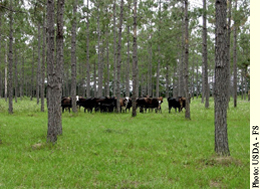 |
| Silvopasture |
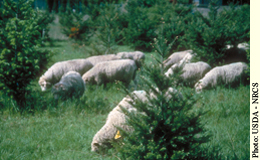 |
| Silvopasture |
Silvopasture is a form of agroforestry that combines trees with forage and livestock production. The trees in a silvopasture system are typically managed for high-value sawlogs and, at the same time, provide shade and shelter for livestock and forage. The partial shade throughout a silvopasture can reduce stress on the animal, and in some cases, it can increase forage production and quality. In plantations of conifers or hardwoods for timber or Christmas trees, managed grazing provides additional annual income from hay or livestock production. Silvopasture is a particularly popular agroforestry system in the Southeast, but it is becoming more popular in other areas across the country where coniferous trees exist. Some nut (e.g. walnut and pecan) and fruit orchards may also be managed as a silvopasture.
Silvopasture is successful when the tree, forage, and livestock components are all compatible.
Alley Cropping
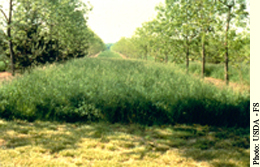 |
| Alley Cropping |
Alley cropping is a type of agroforestry that involves growing an agricultural crop simultaneously with a long-term tree crop. It is broadly defined as widely-spaced rows of trees and/or shrubs (single or multiple), that create alleyways within which agricultural crops or horticultural crops are produced. Alley cropping is usually done with the specific purpose of providing annual income while the tree crop matures. Fine hardwoods, like walnut, oak, and pecan, are favored species in alley cropping systems and can potentially provide high-value lumber or veneer logs. Nut crops can be an intermediate product. In addition to cash crops such as corn, squash, and melon, fruit bearing shrubs such as blueberry and ornamentals can be grown in the alleyways.
Forest Farming
Forest farming is a specific form of agroforestry that involves the cultivation of high-value non-timber crops under the protection of a forest canopy that has been modified to provide the shade level appropriate for a specific crop. Ginseng, shiitake mushrooms, and decorative ferns are all crops that are typically cultivated under forest cover and are sold for medicinal, culinary, and ornamental uses. Forest farming provides annual income while high-quality trees are being grown on a longer rotation for wood products. Additionally, forest farming can promote biodiversity by reestablishing previously exploited, naturally occurring plants. The diversity created with forest farming can also attract a variety of wildlife species.
Riparian Forest Buffers
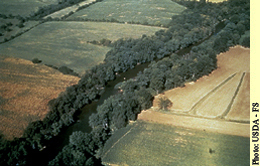 |
| Riparian Forest Buffers |
Riparian forest buffers are a form of agroforestry that involves the natural or re-established streamside forests made up of trees, shrubs, and grasses. They intercept and reduce the impact of non-point source pollution associated with agricultural operations on land adjacent to waterways. Riparian forest buffers also reduce bank erosion, protect aquatic environments from excess nutrients and sedimentation, enhance wildlife, and increase biodiversity.
Windbreaks/Shelterbelts
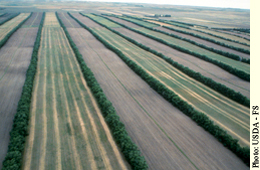 |
| Windbreaks/Shelterbelts |
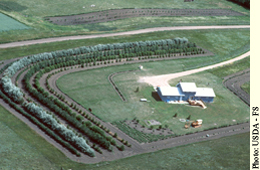 |
| Windbreaks/Shelterbelts |
Windbreaks are linear plantings of trees and shrubs designed to enhance crop production and protect people, livestock, soil, and water. There are several types of windbreaks. Field windbreaks protect a variety of wind-sensitive crops, control wind erosion, and increase bee pollination and pesticide effectiveness. They can also spread snow evenly across a field, increasing spring soil moisture. Livestock windbreaks help reduce animal stress and mortality, reduce feed consumption, and help reduce visual impacts and odors. Living snowfences keep roads clear of drifting snow and increase driving safety. All properly designed windbreaks provide protection for wildlife from harsh winds. Over 50 bird species are known to use windbreaks during the breeding season.
Special Applications
Carbon
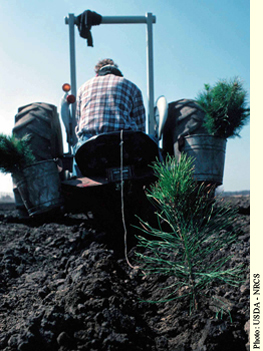 |
| Carbon |
Growing trees remove carbon from the earth’s atmosphere. Several agroforestry applications can lead to substantial removal of carbon dioxide from the atmosphere and carbon storage. These include windbreaks, riparian forest buffers, silvopasture, and short rotation woody crops (SRWC). Properly planned field windbreaks can provide adequate crop and soil protection when only 2-3% of the farmed acres are planted to windbreaks. To illustrate this point, there are 185 million acres of tilled land in the Great/Central Plains. Planting only 2.5 percent of this field area to 30-foot-wide tree windbreaks would span 1.3 million miles and cover 4.6 million acres. As trees continue to grow, more carbon is stored. Carbon dioxide removal, based on 20-year-old plantings, would exceed: 80 million metric tons. In another example, USDA has committed to planting 2,000,000 miles of conservation buffers. If one-fourth of these buffers were 100 foot wide forested riparian buffers, carbon dioxide removal would exceed: 110 million metric tons.
Wildlife Management
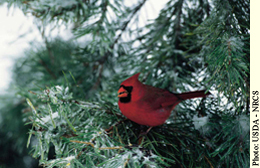 |
| Wildlife Management |
Having trees and shrubs on farms in corridors makes for good wildlife habitat and encourages wildlife movement. Every landscape has, at some point, had a dominant land cover such as woodland or grassland. However, human influences like agriculture, fence rows, roads, and urbanization have dissected this dominant cover making the landscape more suitable for some wildlife species and less suitable for others. Planting trees and shrubs on farms in corridors helps offset fragmentation by providing food, water quality, cover, and territory. All agroforestry applications, from forest farming to special applications, can benefit a wide variety wildlife species.
Waste Management
Excess nutrients and other chemicals from agricultural, municipal, and industrial operations impact surface and ground water quality. Trees can be a natural solution to compromised water quality. Fast growing tree crops, in particular hybrid poplar, hybrid willow, sweetgum, sycamore, yellow poplar, and loblolly pine, can use the water and excess nutrients found in agricultural, municipal, and industrial waste. At the same time, they can breakdown and filter harmful chemicals found in the waste. By applying tailwater, animal waste, and municipal and industrial waste, to trees, you are turning waste into a useful product.
Biomass/Energy
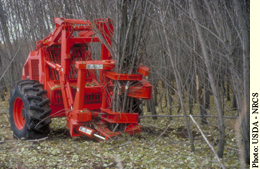 |
| Biomass/Energy |
As Americans search for cleaner, more sustainable energy options, there will be an opportunity in integrating food or energy crops with fast growing trees such as hybrid poplar, hybrid willow, sweetgum, sycamore, and locust. On tree rotation lengths as short 6 and 9 years, farmers and landowners could apply an alley cropping system, with the goals of producing an annual energy crop (e.g., switchgrass) and a longer rotation energy crop (e.g., willow) or producing an annual cash crop (e.g., corn) and a longer term energy crop (e.g., poplar).

